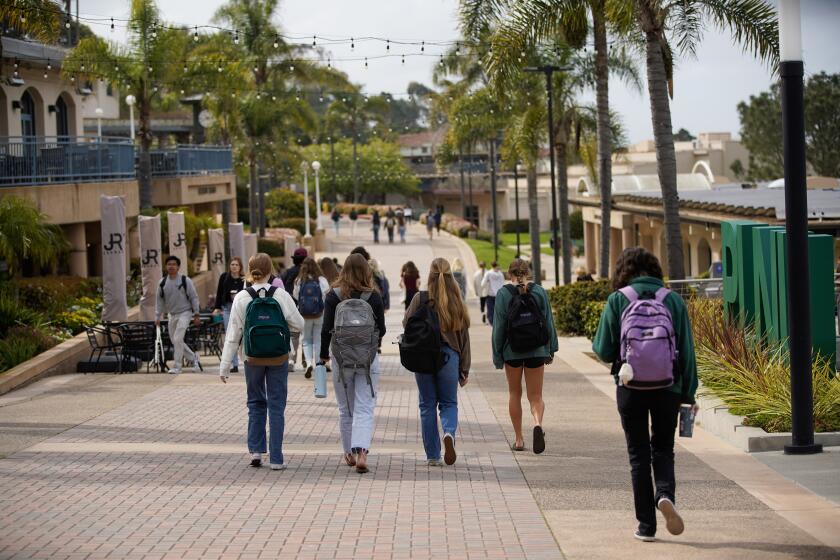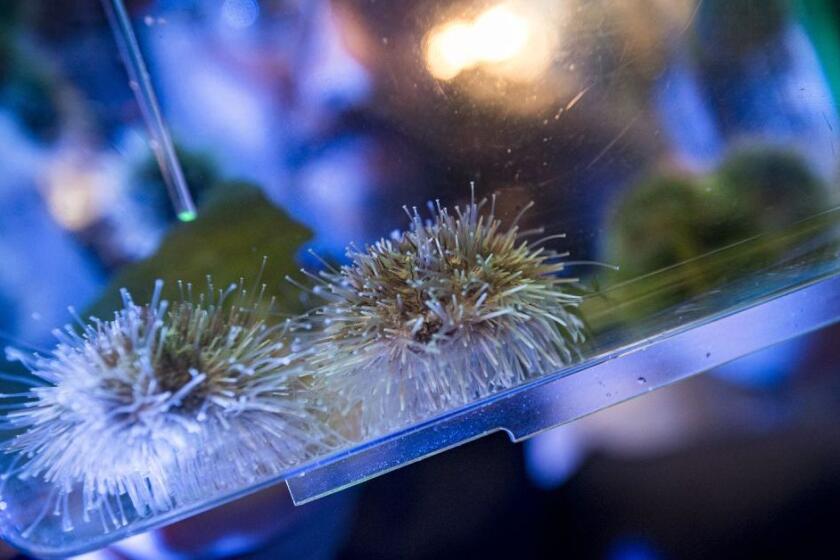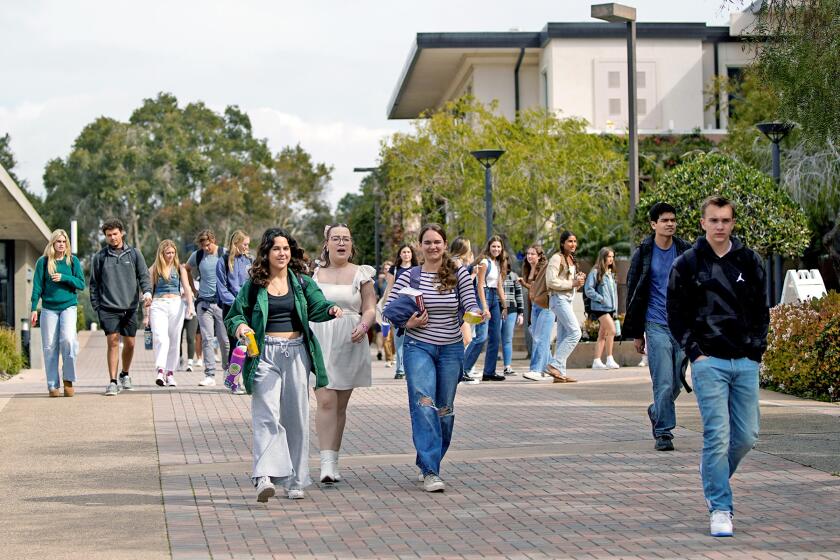Will scientists wipe out disease by 2030?
Is it possible that scientists will be able to wipe out most diseases in about 15 years?
Famed inventor-futurist Ray Kurzweil says yes -- a claim that’s expected to stir debate this week in San Diego when some of the nation’s top thinkers meet to discuss the near-term future of medicine.
More than 750 scientists, engineers, physicians and inventors will attend the sold-out Exponential Medicine conference, which was organized by Singularity University, a Bay-area think tank co-founded by Kurzweil.
The conference will focus on Kurzweil’s belief that many forms of technology will evolve rapidly, greatly improving human health and extending longevity. He is particularly optimistic about “nanobots,” microscopic robots designed to roam around inside the body, fighting disease. Kurzweil says that millions of nanobots will be placed in humans by the 2030s to augment the immune system, vanquishing most diseases. He’s also been quoted as saying it would happen sooner.
Kurzweil also says that human could, for the most part, become immortal by 2040 due to advances in technology and medicine. He believes science will reach a technological singularity five years later, in 2045. Kurzweil has described singularity as: “A future period during which the pace of technological change will be so rapid, its impact so deep, that human life will be irreversibly transformed.
“ Although neither utopian nor dystopian, this epoch will transform the concepts that we rely on to give meaning to our lifes, from our business models to the cycle of human life, including death itself.”
The 67 year-old Kurzweil has many admirers because of the major contributions he’s made to engineering, including the creation of the first flatbed word scanner. He was awarded the National Medal of Technology for his collective creations, and elected to the National Inventors Hall of Fame.
Among the general public, Kurzweil is better known for the bold predictions he’s made about science and health in a series of books, including, “The Singularity is Near: When Humans Transcend Biology”, published in 2006.
Some of his predictions have come true. Others have not. Still others remain unresolved matters, including the future of nanobots.
The tiny machines are in development at such schools as UC San Diego. The field shows promise, but scientists are circumspect about the bots -- and broader efforts to push medicine forward.
“Ray does us a great service by carefully tracking a broad set of exponential technologies,” said Larry Smarr, a UC San Diego computer scientist who helped with the initial planning of Singularity University.
“He gives us an early warning about technological disruptions that can have ethical and legal ramifications that we should be discussing. The nanobots is an emotionally charged topic. A lot of people want it to come true. But you can’t give false hope.
“There’s a lot of basic research still to be done on nanobots, and probably a decade of clinical trials.”
Cardiologist Eric Topol, who has helped test highly advanced medical devices at the Scripps Translational Science Institute in La Jolla, said, “I think we will see nanobots in medicine and they will help manage and even prevent diseases and medical conditions, such as heart attacks.
“ But there are overwhelming genetic and environmental issues(lifestyle, diet, obesity, sedentary behavior, diabetes) that are too pervasive and overriding to ‘wipe out most diseases.’
“Just like the Singularity, Ray Kurzweil has good ideas but gets carried away. There’s not going to be any Singularity—always a Plurality.”
The course of science seems far brighter to Peter Diamandis, the engineer-inventor who co-founded both Singularity University and Human Longevity, Inc., the La Jolla company that’s trying to become the world’s largest gene sequencing company.
Diamandis wasn’t available to speak about the Exponential Medicine conference. But during a March 2014 interview with the San Diego Union-Tribune, he suggested that scientists take a broader look at what they’ve already accomplished.
“We are constantly resetting our expectations,” Diamandis said. “A century ago if you lived over the age of 50 you were lucky. The average human lifespan at the turn of the 19th century was 45-to-50 years old. It is now well over 70 and in some places even 80. “We have the people in their mid-80s coming down with Alzheimer’s disease and cancer. It’s an an epidemic because we have extended human life to the point where these things start showing up.
“Now the question is can we continue to increase human aging? The answer is yes, but we need to make sure we are living a higher quality of older life. My shorthand for this is to say that our goal is to make 100 the new 60. There’s no reason why we can’t see 100, with people being vibrant and healthy.”
Diamandis added: “ We are on the verge of unlocking a lot of the fundamentals of why we get cancer, of why we get Alzheimer’s, why we get heart disease. And not only why, but how you prevent them. Those are the three horsemen of mortality right now.”
CONFERENCE TALKING POINTS:
HUMAN GENETICS: When the Human Genome Project was completed in 2003, there was lots of hope that researchers would quickly identify many of the genes that cause disease and find ways to neurtralize them. Some progress has been made, notably in cancer. But scientists are struggling to clearly identify which of our nearly 21,000 genes pose a threat. And most efforts to treat people through gene therapy haven’t worked.
Biologist James Watson -- who shared the 1962 Nobel Prize in physiology or medicine for helping discover the structure of DNA -- summed up the frustration of many scientists recently when he gave a lecture on cancer at Human Longevity, Inc.
“There are so many genes, which makes all of this so complicated,” Watson said. “ I wish we had fewer genes.”
THE MICROBIOME: There’s a growing realization that studying the trillions of microbes that live in and on people is just as important as studying human genetics. The microbes can help keep a person healthy and contribute to disease, including diabetes, inflammatory bowel disease, and depression.
Scientists at UC San Diego and dozens of other universities are quickly ramping up their efforts to sequence and study the DNA of these microbes, which is collectively known as the microbiome.
”The potential impact of the microbiome is very large,” said Rob Knight, a UC San Diego computational biologist. “If you look at some of the major chronic diseases of a century ago, including Hansen’s disease, (leprosy), syphilis, pellagra, and rickets, many of them were essentially eliminated by advances in single-organism microbiology or advances in nutrition.
” It’s possible that in the same way, many chronic diseases involving the immune system today, including not just inflammatory bowel disease and rheumatoid arthritis but obesity, depression, and autism, will be treatable with the right microbiome-based approach. However, this doesn’t mean that the cure for all diseases will be found in the microbiome; rather, it has a lot of potential for addressing many diseases we currently don’t have good solutions for.”
LIQUID BIOPSY: About 590,000 people die of cancer each year in the US. Only heart disease kills more people. Scientists have made progress in understanding how and why cancer develops. There have been gains in treating some forms of the disease. And researchers are hopeful that immunotherapy -- one of the hottest fields in medical science -- will prove effective in battling cancer.
But there’s broad agreement that scientists won’t be able to slash the number of cancer deaths until they come up with better ways to detect and monitor the disease earlier.
Liquid biopsies might represent the advance that researchers have been looking for.
The term refers to simple blood tests that can detect potentially harmful tumor cells and mutated DNA traveling through the blood stream. The tests have recently emerged as a possible alternative to tissue biopsies, which are often painful, invasive and of limited value.
About a half dozen companies in San Diego County have begun using or marketing liquid biopsies. There also has been some clinical testing at UC San Diego.
There’s cautious optimism in the scientific community.
Earlier this year, San Diego oncologist and tech investor Ivor Royston told the Union-Tribune: “We need to do more than just say cancer cells were found.. We need clinical studies that show that liquid biopsies can help doctors choose the right drug, at the right time, to stop cancer.
“This is an emerging technology, but it’s emerging fast. It’s nice to see San Diego taking a lead in the field.”






